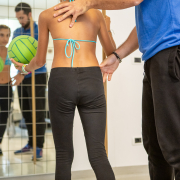Pelvic rotation parameters related to in-brace correction in patients with idiopathic scoliosis
Every year, the Italian Scoliosis Study Group selects the best published papers on conservative spine treatment from the global scientific literature.
Here is the abstract from one of these papers.
Pelvic rotation parameters related to in-brace correction in patients with idiopathic scoliosis
Kepeng Li, Jun Miao, Jingan Zhang
September 2020, European Journal of Medical Research 25(1):41
Background
To identify the pelvic parameters affecting in-brace correction (IBC) in patients with idiopathic scoliosis (IS).
Methods
Patients with IS receiving Chêneau brace treatment in our scoliosis center from January 2019 to November 2019 were retrospectively analyzed. Pelvic rotation parameters, including pelvic incidence (PI), sacral slope (SS), pelvic tilt (PT), L/R ratio, were collected. Other radiographic data, such as Risser sign, coronal and sagittal balance, curve location, kyphosis, lordosis of each patient were also recorded to analyze their correlations with IBC. Correlation analyses were performed to identify the classified variables influencing IBC. The principal component analysis was used to extract common factors of radiographic parameters to eliminate interaction effects. The linear regression equation was established using principal components, the variables influencing IBC were identified.
Results
A cohort of 44 patients with IS (36 girls and 8 boys) were included in the present study. The mean IBC was 49.87% (range, 3%–100%). IBC of lumbar IS was negatively correlated with apical rotate factor (ARF, B = –0.385), mainly consisted of pelvic coronal plane rotation (PCPR, 0.449), Cobb angle (CA, 0.575), apical vertebral rotation (AVR, 0.918), and pelvic rotate factor (PRF, B = –0.387), mainly consisted of PT (0.861), PI (0.728), PCPR (–0.570). The regression equation of lumbar IS had statistical significance (F = 6.500, P = 0.005, R2 = 0.317), whereas statistically significance was not found in the regression equation of thoracic IS (F = 2.913, P = 0.106). The remaining parameters were not related to IBC.
Conclusions
For lumbar IS, ARF and PRF have negative effects on IBC, coronal and sagittal rotation of the pelvis is related to IBC.





Leave a Reply
Want to join the discussion?Feel free to contribute!